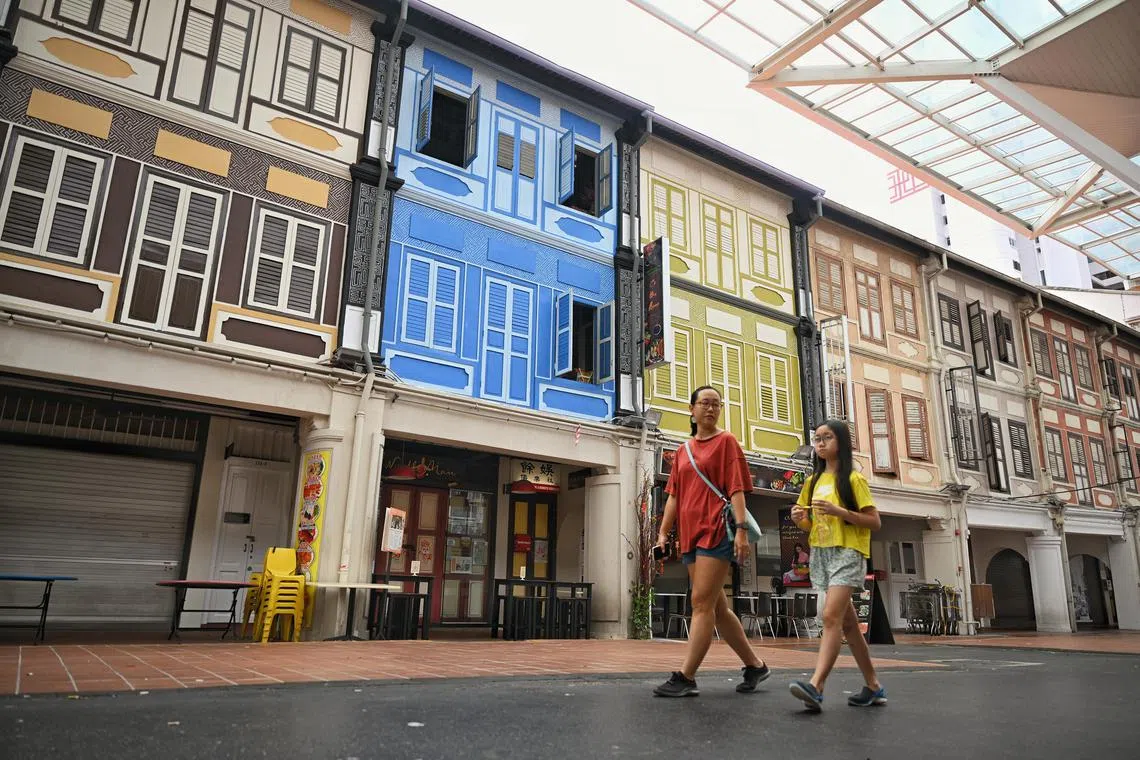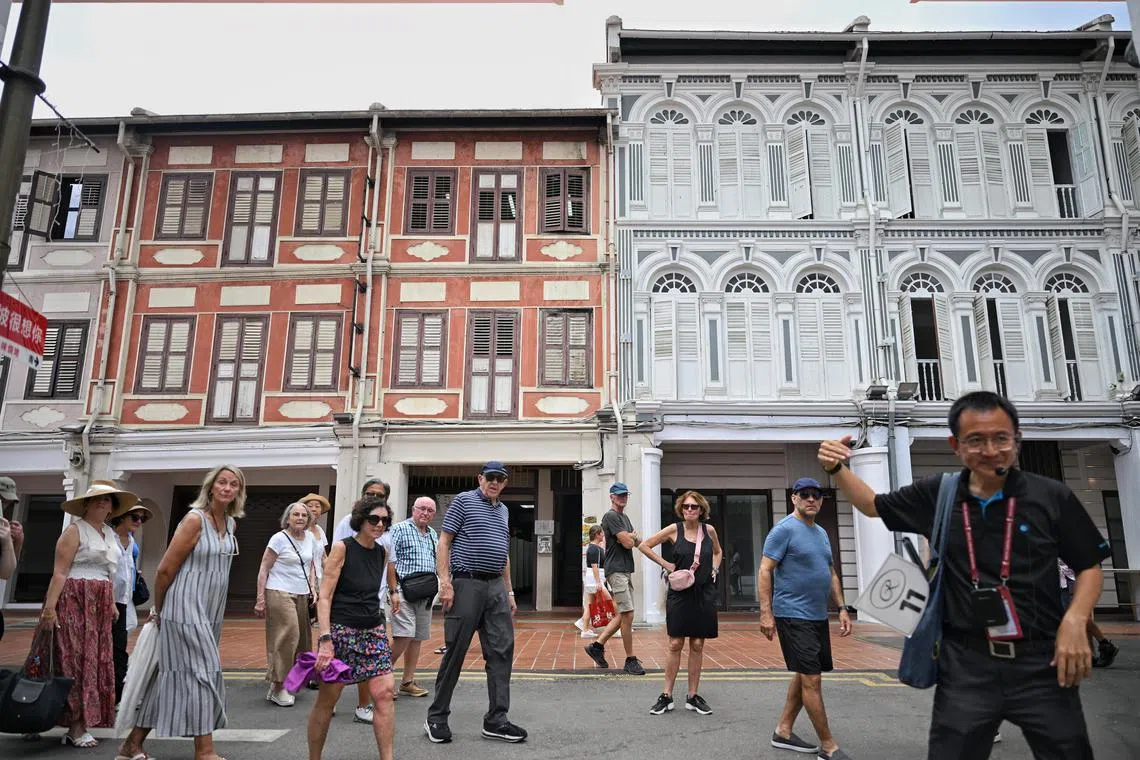Smith Street to be rejuvenated to increase vibrancy and footfall to Chinatown
Sign up now: Get ST's newsletters delivered to your inbox

Singapore's iconic Smith Street is set to be rejuvenated with differentiated offerings and renewed experiences for locals and tourists alike.
ST PHOTO: SHINTARO TAY
Follow topic:
SINGAPORE – Smith Street, located in the Chinatown conservation area, will be rejuvenated to inject vibrancy and drive greater footfall to the area.
Known for its culinary offerings, it will soon feature more diverse experiences, such as gamified tours, arts and cultural galleries, local artisans and co-living/co-working concepts, while preserving the area’s cultural and architectural heritage.
The Singapore Land Authority (SLA), Singapore Tourism Board (STB) and Urban Redevelopment Authority jointly launched a collective tender on Nov 30 to appoint a master tenant to rejuvenate the row of shophouses from 11 to 37 Smith Street, as well as the adjacent pedestrian mall on state land.
This covers a land area of 3,166 sq m and a gross floor area of 3,073 sq m. The successful bidder will be offered an upfront tenure of five years, renewable for a second term of four years, to facilitate better resource planning.
Smith Street was where Chinatown Food Street was sited.
Opened in 2001 as part of STB’s efforts to revitalise Chinatown, it boasted a cluster of popular hawker food carts along a 100m stretch that was closed to vehicular traffic. It shuttered in October 2021 during the Covid-19 pandemic.
Smith Street will continue to have an array of food and beverage offerings and new dining concepts reflecting Singapore’s multicultural identity.
In its early days, Smith Street was also known as Hei Yuen Kai (Cantonese for Theatre Street) for the many Chinese operas held there.
The rejuvenation project aims to bring back that vibrancy with regular community programming at the pedestrian mall, and shops and restaurants on the first storey of the shophouses. Community and grassroots organisations will continue celebrating festive occasions in the street.
The project will also showcase the traditional trades in the historic district with boutiques, local artisans, crafts and unique products that reflect Singapore’s cultural diversity.
The upper storeys of the shophouses could be used as serviced apartments, and co-living and co-working spaces that allow users to immerse themselves in the precinct’s cultural heritage.
The tender proposals must demonstrate sustainability goals and outcomes in line with the Singapore Green Plan 2030, such as infrastructure improvements, environmentally friendly practices in day-to-day business operations and programmes to raise awareness of environmental sustainability.
The rejuvenation will preserve Chinatown’s cultural and architectural heritage, and follow conservation guidelines and best practices. This will ensure that the conserved shophouses continue to retain their intrinsic character and historical value, said the agencies.

The rejuvenation will preserve Chinatown’s cultural and architectural heritage following conservation guidelines and best practices.
ST PHOTO: SHINTARO TAY
Ms Carrie Wong, SLA’s director for business planning and development, said the joint tender underscores Singapore’s commitment to preserve its rich cultural heritage while adapting to the needs and preferences of residents and international visitors.
“We are excited to introduce a multifaceted experience that not only honours tradition but also embraces modernity,” she said. “It is testament to our commitment to innovation and sustainability, making it a world-class destination for everyone to enjoy.”
Ms Lim Shoo Ling, STB’s director for the arts and cultural precincts, said the agency works closely with the local community and precinct businesses to bring to life the authentic stories and experiences of Singapore’s heritage and culture.
Mr Bernard Leong, chairman of the Chinatown Business Association, said the association is planning events, promotions and cultural showcases.
When contacted by The Straits Times, Mr Leonard Tay, head of research with Knight Frank, said it takes courage to focus on the culture and history of a place.
“Culture and history may not translate to dollars and cents in today’s context,” he said. “Showcasing the richness of the past should be a priority instead of having to conceptualise something that yields the highest or best economic returns.”

The project will also showcase the traditional trades in the historic district with boutiques, local artisans, crafts and unique products that reflect Singapore’s cultural diversity.
ST PHOTO: SHINTARO TAY
Bidders will need to consider conservation and restoration guidelines, logistics and operational constraints of the development to be able to bring alive their vision, while making this a viable financial investment, said Ms Yap Hui Yee, Savills Singapore’s executive director of investment sales and capital markets.
“The concept will need to be unique to reflect and celebrate the locale sufficiently with an eye to also appeal beyond history buffs, making it accessible to families both local and overseas,” she added.
Mr Govinda Singh, Colliers’ executive director and head of hotels and leisure and real estate advisory, said what made the Chinatown precinct an attraction was its eclectic mix of local shop owners and peddlers blending seamlessly into the heritage and architectural look and feel.
“(Bidders) should be wary that this is what was missing over the last few years and engage with locals and stallholders alike to bring back energy to the area,” he said.
“Any concept should go further in being able to drive local footfall throughout the day and night, as this is what will give it life and attract tourists once again en masse.”

